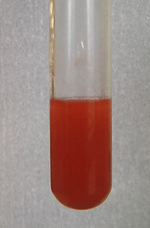Antimony triiodide
Antimony triiodide is the chemical compound with the formula SbI3. This ruby-red solid is the only characterized "binary" iodide of antimony, i.e. the sole compound isolated with the formula SbxIy. It contains antimony in its +3 oxidation state. Like many iodides of the heavier main group elements, its structure depends on the phase. Gaseous SbI3 is a molecular, pyramidal species as anticipated by VSEPR theory. In the solid state, however, the Sb center is surrounded by an octahedron of six iodide ligands, three of which are closer and three more distant.[5] For the related compound BiI3, all six Bi—I distances are equal.[6]
| |||
 | |||
| Names | |||
|---|---|---|---|
| IUPAC name
Antimony triiodide, Antimony(III) iodide | |||
| Systematic IUPAC name
Triiodostibane | |||
| Identifiers | |||
3D model (JSmol) |
|||
| ChemSpider | |||
| ECHA InfoCard | 100.029.278 | ||
| EC Number |
| ||
PubChem CID |
|||
| UNII | |||
CompTox Dashboard (EPA) |
|||
| |||
| |||
| Properties | |||
| I3Sb | |||
| Molar mass | 502.473 g·mol−1 | ||
| Appearance | red crystals | ||
| Density | 4.921 g/cm3 | ||
| Melting point | 170.5 °C (338.9 °F; 443.6 K) | ||
| Boiling point | 401.6 °C (754.9 °F; 674.8 K) | ||
| soluble, partially hydrolyses | |||
| Solubility | soluble in benzene, alcohol, acetone, CS2, HCl, KI, SnCl4, C2H7N ,HI,alkali metal triiodides insoluble in CHCl3, CCl4[1] | ||
| Solubility in diiodomethane | 10.15% v/v (12 °C)[2] | ||
| -147.0·10−6 cm3/mol | |||
| Structure | |||
| Rhombohedral, hR24, | |||
| R-3, No. 148 | |||
| 1.58 D | |||
| Thermochemistry | |||
Heat capacity (C) |
81.6 J/mol·K (gas)[1] | ||
Std enthalpy of formation (ΔfH⦵298) |
-100.4 kJ/mol[1] | ||
| Hazards | |||
| GHS pictograms |   | ||
| GHS Signal word | Warning | ||
GHS hazard statements |
H302, H332, H411[3] | ||
| P273[3] | |||
| NIOSH (US health exposure limits): | |||
PEL (Permissible) |
TWA 0.5 mg/m3 (as Sb)[4] | ||
REL (Recommended) |
TWA 0.5 mg/m3 (as Sb)[4] | ||
Except where otherwise noted, data are given for materials in their standard state (at 25 °C [77 °F], 100 kPa). | |||
| Infobox references | |||
Production
It may be formed by the reaction of antimony with elemental iodine, or the reaction of antimony trioxide with hydroiodic acid.
Alternatively, it may be prepared by the interaction of antimony and iodine in boiling benzene or tetrachloroethane.
Uses
SbI3 has been used as a dopant in the preparation of thermoelectric materials.[7]
References
- http://chemister.ru/Database/properties-en.php?dbid=1&id=5180
- Seidell, Atherton; Linke, William F. (1952). Solubilities of Inorganic and Organic Compounds. Van Nostrand. Retrieved 18 May 2017.
- Sigma-Aldrich Co., Antimony(III) iodide. Retrieved on 2014-05-29.
- NIOSH Pocket Guide to Chemical Hazards. "#0036". National Institute for Occupational Safety and Health (NIOSH).
- Hsueh, H.C.; Chen, R.K.; Vass, H.; Clark, S.J.; Ackland, G.J.; Poon, W.C.K.; Crain, J. (1998). "Compression mechanisms in quasimolecular XI3 (X = As, Sb, Bi) solids" (PDF). Physical Review B. 58 (22): 14812–14822. doi:10.1103/PhysRevB.58.14812.
- Holleman, A. F.; Wiberg, E. "Inorganic Chemistry" Academic Press: San Diego, 2001. ISBN 0-12-352651-5.
- D.-Y. Chung; T. Hogan; P. Brazis; M. Rocci-Lane; C. Kannewurf; M. Bastea; C. Uher; M. G. Kanatzidis (2000). "CsBi4Te6: A High-Performance Thermoelectric Material for Low-Temperature Applications". Science. 287 (5455): 1024–7. doi:10.1126/science.287.5455.1024. PMID 10669411.
External links
| Wikimedia Commons has media related to Antimony triiodide. |
| HI | He | ||||||||||||||||
| LiI | BeI2 | BI3 | CI4 | NI3 | I2O4, I2O5, I4O9 |
IF, IF3, IF5, IF7 |
Ne | ||||||||||
| NaI | MgI2 | AlI3 | SiI4 | PI3, P2I4 |
S | ICl, ICl3 |
Ar | ||||||||||
| KI | CaI2 | Sc | TiI4 | VI3 | CrI3 | MnI2 | FeI2 | CoI2 | NiI2 | CuI | ZnI2 | Ga2I6 | GeI2, GeI4 |
AsI3 | Se | IBr | Kr |
| RbI | SrI2 | YI3 | ZrI4 | NbI5 | Mo | Tc | Ru | Rh | Pd | AgI | CdI2 | InI3 | SnI4, SnI2 |
SbI3 | TeI4 | I | Xe |
| CsI | BaI2 | HfI4 | TaI5 | W | Re | Os | Ir | Pt | AuI | Hg2I2, HgI2 |
TlI | PbI2 | BiI3 | Po | AtI | Rn | |
| Fr | RaI2 | Rf | Db | Sg | Bh | Hs | Mt | Ds | Rg | Cn | Nh | Fl | Mc | Lv | Ts | Og | |
| ↓ | |||||||||||||||||
| La | Ce | Pr | Nd | Pm | SmI2 | Eu | Gd | TbI3 | Dy | Ho | Er | Tm | Yb | Lu | |||
| Ac | ThI4 | Pa | UI3, UI4 |
Np | Pu | Am | Cm | Bk | Cf | EsI3 | Fm | Md | No | Lr | |||

